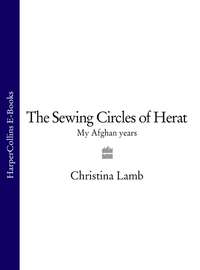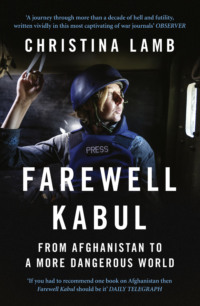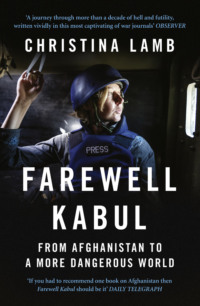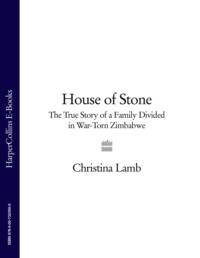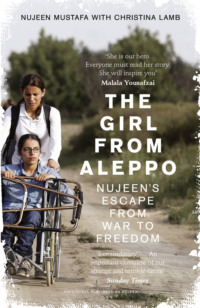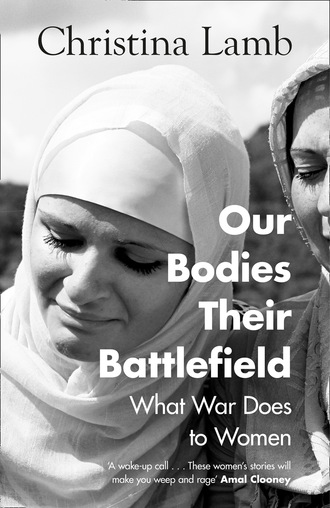
Полная версия
Our Bodies, Their Battlefield
Around the world a woman’s body is still very much a battlefield, and hundreds of thousands of women bear the invisible wounds of war.
And so I set out to tell some of these women’s stories in their own words. It would be the start of a shocking journey through Africa, Asia, Europe and South America to explore some of the darkest deeds known to man. The more places I went to the more prevalent I found rape was, because of the repeated failure of the international community and domestic courts to bring perpetrators to justice.
These are not easy stories to tell or to listen to. But they are often ones of astonishing bravery and heroism.
Women are not just bystanders of history. It’s time to stop only telling half the story.
1
On Mussolini’s Island
Leros, August 2016
When I look back to that summer on the tiny Greek island of Leros, to the derelict mental asylum littered with pigeon droppings and rusting iron bedsteads, where I first met the Yazidis, I still see the girl’s eyes, so deep and troubled and pleading.
She is thrusting her phone at me to show me a video. I can see an iron cage with perhaps a dozen young women inside and Arabic men crowded around jeering, Kalashnikovs on their shoulders. At first, I don’t understand. The women look petrified. Then the men step back, flames engulf the cage, there are screams and the video ends.
‘That is my sister,’ said the girl. ‘They are burning virgins alive.’
Everything seems to stop and spin. It is a vision of Hell. I don’t know if the sound in my head is the sea outside or blood rushing to my ears. Sun is pouring through a hole in the roof and sweat is running down our faces. A small Yazidi child is trailing through the rubble and broken glass and downed rafters, singing to herself, a waif of a thing with strands of hair stuck to her cheek like fronds. She is getting closer and closer to a large crater in the floorboards until, in panic, I yank her away. Her mother, resting against a stone wall next to the girl whose sister was burnt alive, stares blankly ahead. What has happened to these people?
I want to get out of that asylum with its barred windows and stained walls. Before coming here I’d watched an old documentary called ‘Island of Outcasts’ and images crowd into my head from that film of shaven-headed men and women, some of them naked and chained to their beds, limbs jerking at strange angles, others in shapeless smocks, crammed on the floor of a room staring into the camera.
Through the window’s bars, I can see down below, row upon row of white prefab containers surrounded by wire concertina fence, and beyond that the Aegean Sea, jarring in its deep blue perfection.
The camp where these Yazidis are living is more than a thousand miles from their homeland under the tall sacred mountain between Iraq and Syria on which they believe Noah’s Ark came to rest.
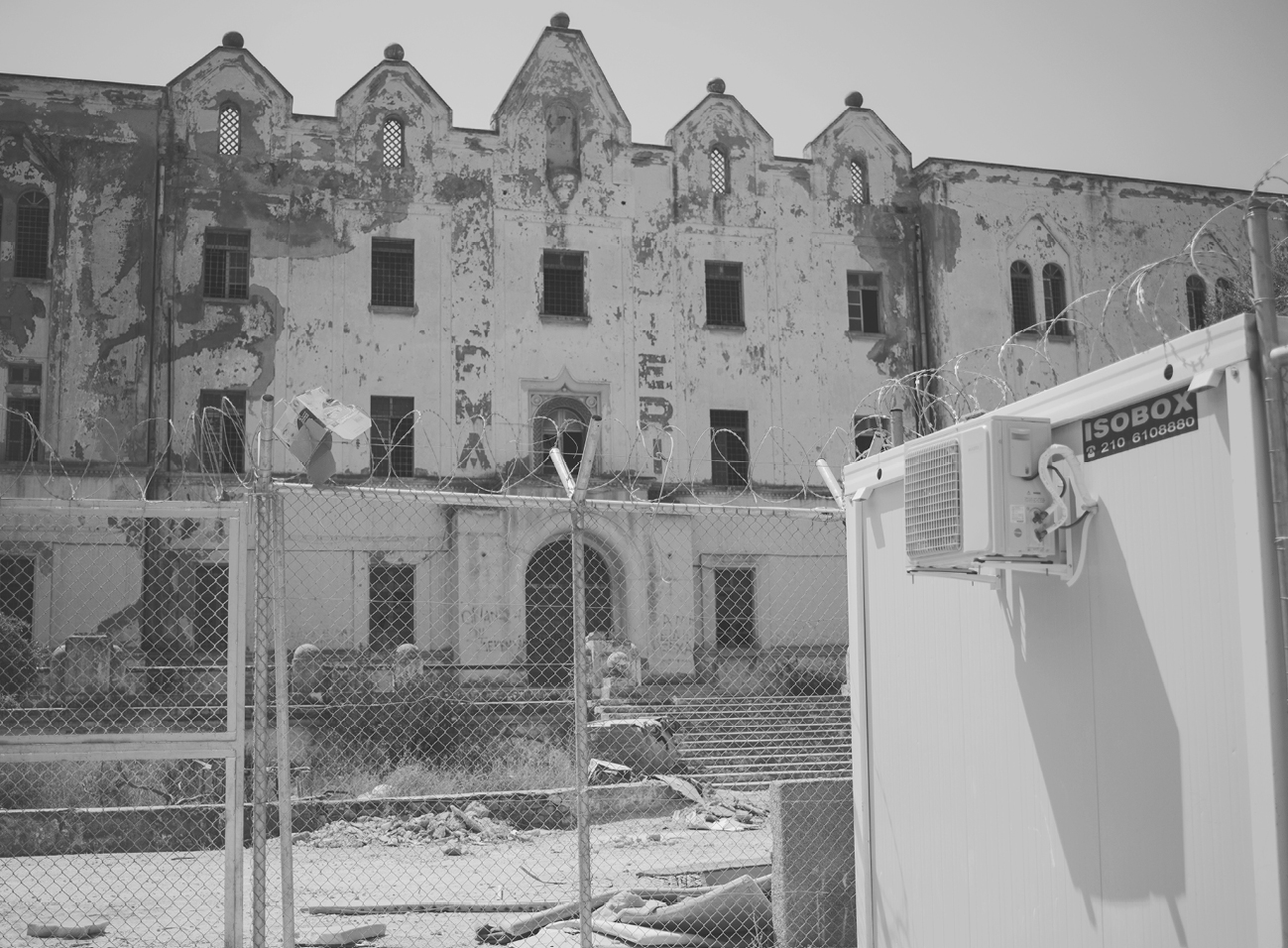
Living in containers in the shadow of the derelict asylum (Georgios Makkas/Panos Pictures)
I had never before met Yazidis. Their religion is one of the world’s most ancient but, like most people, the first I had heard of them was at the end of summer in 2014 when I saw the pictures of thousands of Yazidis trapped on that mountain where they had fled convoy after convoy of black-clad ISIS fighters intent on exterminating them.
In the ruins of that asylum that sweltering August day, one after another came forward from the shadows to tell me their stories, stories that shook my very core, were worse than anything I had heard in three decades as a foreign correspondent.
Broken people, the women with thin wavy bodies and long purplish hair framing faces drained of light, it seemed to me they were neither living nor dead. All had lost parents, brothers, sisters. In whispery voices like wafts of wind, they told of their beloved homeland of Sinjar, which they pronounced as Shingal, and the mountain of the same name which they thought would give sanctuary but where many perished of hunger and thirst. They told of a small town called Kocho, which ISIS had kept under siege for thirteen days then slaughtered all the men and older women and captured the virgins. And of the Galaxy Cinema, on the east bank of the Tigris river, where girls – some of them their sisters – were divided into ugly and beautiful then paraded to ISIS fighters in a market to be bought as their sex slaves.
The mother of the little girl who almost walked into the hole was from Kocho. She was thirty-five, her name was Asma Bashar and her voice was staccato like a machine gun. The others called her Asma Loco because they said she had lost her mind. She told me that forty members of her family had been slaughtered, including her mother, father and brothers. Four sisters and twelve nieces had been taken as sex slaves. ‘I have no one left but one sister who managed to escape from captivity and is now in Germany,’ she said. ‘I take pills to try and blot out what happened.’
A younger woman who until then had stood still as a portrait against the cracked blue wall, started speaking. ‘I am twenty but I feel more than forty,’ she said. Her name was Ayesha and she told me her parents and brothers were killed in Kocho. ‘I saw my grandmother die, I saw children die and now I just remember bad things. Four of my friends were sold for just twenty euros.’
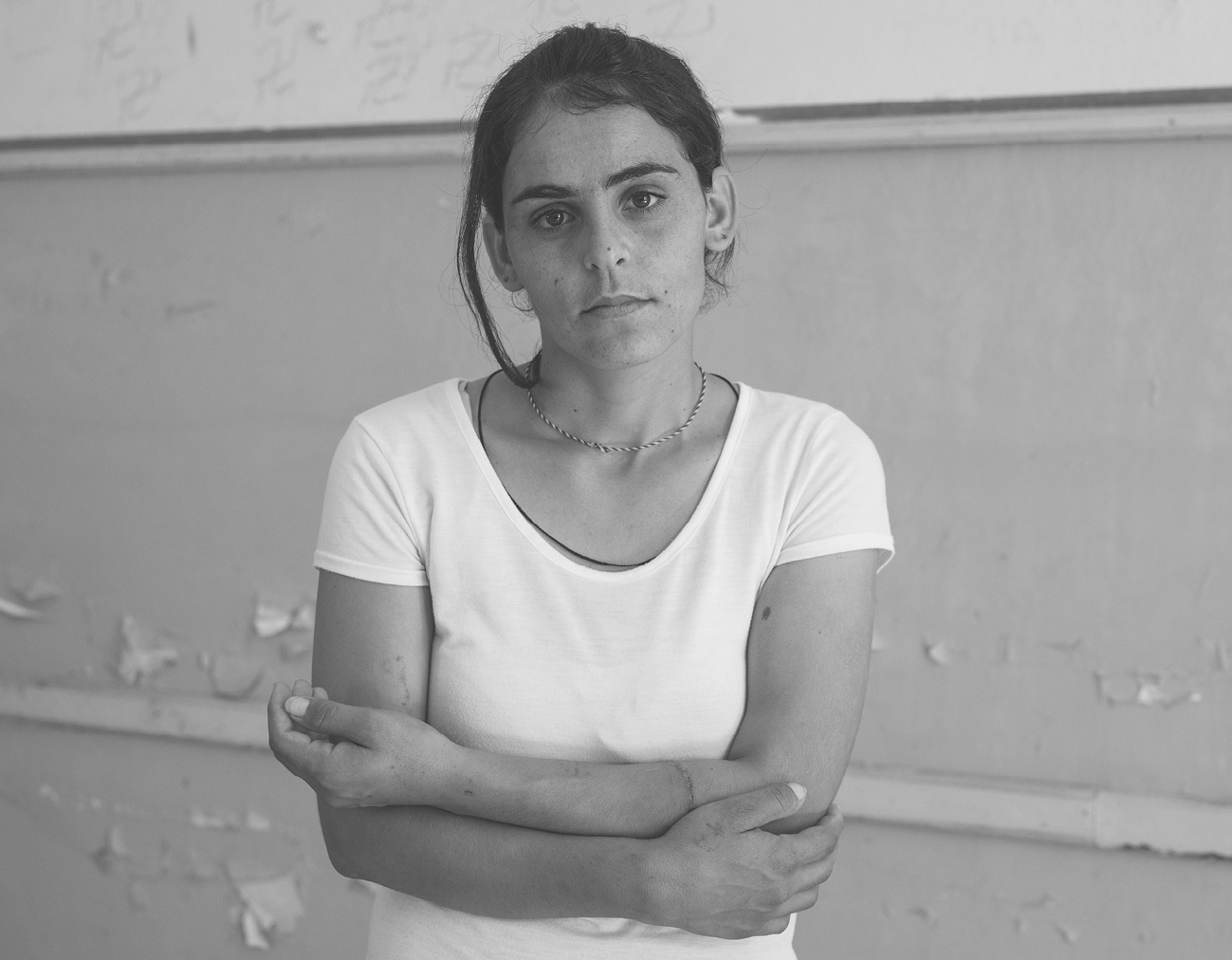
Ayesha, whose parents and brothers were killed by ISIS (Georgios Makkas/Panos Pictures)
She had managed to flee to the mountain with her husband then they had somehow made their way across war-torn Syria into Turkey. There they had paid $5000 to people smugglers to cross the Aegean to Greece, making several abortive attempts in patched-up overcrowded dinghies before finally landing on the island.
‘After all this we find we are still not free,’ she said. She held out her left wrist. Raised red scars criss-cross the pale skin like angry worms. ‘I tried to kill myself with a knife,’ she shrugged. The last time had been just two weeks earlier.
Leros has always been an island of outcasts – a leper colony, an internment camp for political prisoners and an asylum for so-called ‘untreatables’. In 2015 it became one of many Greek islands that had been swamped by refugees, fleeing war in Syria, Iraq and Afghanistan.
It was the refugee crisis that had brought me as a journalist to the island. Leros was one of five Greek islands that had been declared ‘hotspots’ after the European Union struck a deal with Turkey in 2016, paying them three billion euros to stop any new arrivals crossing the Aegean. Ten thousand refugees left stranded on the islands were concentrated in these five processing centres but the process was so slow they were in effect island prisons. I’d been to others in Lesbos, Chios and Kos and witnessed the uneasy juxtaposition of these desperate refugees fenced in camps, stadiums and former factories, so preyed on by sex-traffickers that women wore nappies at night in order not to have to leave their tents, while nearby carefree holidaymakers were enjoying the sun, sea and moussaka washed down by ouzo.
Leros was different. I’d never been anywhere quite like it. It had the blinding white fishing villages of higgledy-piggledy houses, windmills, tavernas and sparkling blue seas typical of the Greek islands. But its main town Lakki was a study in Stalinist art deco, all wide avenues and sharp-angled villas in stark concrete, with a colonnaded cinema, a circular marketplace, a school that resembled an agricultural silo, a minimalist clock tower, as well as buildings that looked like a UFO and an old-fashioned transistor radio. It was like stumbling across a forgotten film set.
The island had once been central to Mussolini’s plans to create a second Roman Empire. Leros, along with all the Dodecanese, had been seized from the Ottoman Turks in 1912, becoming part of an Italian colonial empire that included Libya, Somalia and Eritrea. When Mussolini took power in the 1920s, he decided its deep natural harbour made the ideal naval base from which to establish control over the entire eastern Mediterranean. So he sent in naval forces and administrators, as well as architects to plan a modern city in the fascist style the Italians call razionalismo.
After Italy was defeated in the Second World War, control of the islands passed to Greece, and Lakki (or Portolago as the Italians had called it) was largely abandoned. When the colonels later seized power in Greece in 1967, they used Mussolini’s naval barracks to lock up political prisoners, then as a place to banish the mentally ill. Thousands of patients were shipped from the mainland and kept in medieval conditions until this was exposed in the press and the 1990 documentary I had seen, which prompted outrage across the EU and led to its closure in 1997. Then came the refugees.
To get to the refugee camp I drove past a series of abandoned brick buildings and rusted ambulances. A few people came out to stare including a wild-eyed man pushing a wheelbarrow and waving a fist – some patients had remained.
It was an eerie place for a camp. Inside were about 700 Syrians, Iraqis, Afghans and Pakistanis, a third of whom were children. There were around a hundred Yazidis. These refugees made up 10 per cent of the population of the small island.
Up close the white containers turned out to be Iso-Boxes designed for transporting food, now turned into homes, with lines of laundry strung between them and old men crouched outside playing improvised backgammon with bottle tops. Conditions were not bad compared to some camps I had visited but, as its administrator Yiannis Hrisafitis pointed out, ‘This wasn’t their dream.’ They were not allowed to leave the island and so were stranded in limbo while EU countries failed to agree who would take them. Meanwhile they had nothing to do, nothing to think about but their terrible memories, and no hope for the future.
I wandered between the laundry lines followed by a small boy clutching a large teddy bear, who ran away when I tried to speak to him. A gaggle of Syrian women sat on a bed smoking, their faces deeply lined. The local hospital had told me that there were regular suicide attempts.
The camp was surrounded by a double fence topped with whorls of razor wire like a prison. ‘It’s to stop those from outside coming in,’ explained Yiannis. ‘Maybe somebody wants to steal children or young women or buy organs or sell drugs.’
The Yazidi section had another fence round it to make a camp within a camp. Yiannis explained that a couple of weeks before my visit the Yazidis had been attacked by other refugees, Sunni Muslims, who denounced them as devil worshippers just as ISIS had done, so he had cordoned them off for their own protection. They had gone to the asylum to talk to me because they considered it safer.
I noticed the Yazidis all had red and white cords twisted round their wrists. When I asked what these signified, they explained that the white symbolised the peace they yearn for, and the red the blood of their people killed in previous genocides – by Muslims, Persians, Mongols, Ottomans, Iraqis … all their neighbours. They told me the latest genocide, by ISIS, was the seventy-fourth. There had been so much violence against Yazidis that they had a word for attempted extermination – ferman – long before its English equivalent, genocide, which was coined only in 1944 by Polish lawyer Raphael Lemkin.
‘Here is like a prison, everyone fighting each other,’ said Ayesha, the very still girl who seemed to have stepped out of a painting. ‘We have nothing left, no money, we spent everything to get here and the world does not care about us.’
On my last day on the island the Yazidis told me of a secret village in Germany where they said more than a thousand of the girls kept as sex slaves were being sheltered after having escaped or been rescued. I was intrigued.
2
The Girls in the Forest
Baden Württemburg
Turko looked down at her wrist on which she wore a bracelet of blue glass-eye beads common in the Middle East as protection against the evil eye, as well as one of the twisted red-and-white genocide cords, and she fiddled with them. ‘How does it help me to tell my story?’ she asked.
That was a difficult question. Turko was from Kocho, the village where ISIS massacred 600 people and abducted many girls. She told me she was thirty-five but with her dark hair scrunched back from a face that looked as if it had had all the light drawn out, she looked ten years older.
I was torn between the journalistic desire to know, the fear of what she might have to say, and above all the concern that telling me her story would bring her more grief. I looked around the small room she had been living in for the last year, sparsely furnished with a single bed, small wardrobe and a few photographs of children taped on the wall, almost like a student’s room. Outside the window was nothing but dark forest.
‘Maybe so it never happens again to other women,’ I ventured. ‘But don’t say anything you don’t want to.’
Turko fixed her eyes on me as if staring into my soul. Then she started speaking. ‘Everything began that first Sunday in August two years ago when Daesh moved into Sinjar,’ she said. ‘We thought the peshmerga [Kurdish militia] who manned the checkpoints would protect us but they had fled.
‘I used to work doing odd jobs in the fields and was with my mother and three-year-old niece early that morning when three cars roared up and armed men in black jumped out. They rounded up about forty people and shoved us into a chicken shed where they said “Give us your phones, gold and money!” They took everything we had.
‘Then they separated the men from the women and children. My uncle and cousin were with us and they took them to the fields. Then we could hear the bullets, rat-a-tat-tat, one after another.
‘We started shaking. They put us in a truck and drove us past the dead bodies of the men to Badosh prison. The prisoners had been released and they had filled it with women, hundreds of women. It was a kind of Hell. We were given no food or water, just a piece of dry bread each day. We were so desperate we were forced to drink from the latrines.
‘On the first day the fighters brought a long-bearded man with three Korans who told us he would teach us Islam. We said no, we don’t want your religion, we want our families back. That made them angry. They pointed their guns at us and said “We’ll kill you if you don’t convert!” Then they pushed us against the wall and beat us with wooden sticks.
‘We marked a notch on the wall for each night. After fifteen days we were loaded in buses to Tal Afar, and taken to a hotel where we were penned with hundreds of women. First they separated children under twelve then they divided us into married women and virgins. I pretended to be the mother of my three-year-old niece to avoid being taken with the virgins.
‘We were kept in that hotel for two months. Sometimes ISIS fighters came and beat everyone and took a woman or young girl for two days then brought them back. For a while I was taken with some of the older women and mothers to the next village to work in a bakery and make food. But then they realised the children were not ours and said they would take us to Syria.’
She stopped for a cigarette and drew on it heavily, her hand shaking.
‘We got to Raqqa about 11 p.m.,’ she continued. ‘They took us to a two-storey building with about 350 women and girls. Every day people were coming and looking at us then women would be taken and handed out to ISIS men.’
Turko was kept in that market for forty days, fearful every day. In the end it was her turn. She and her little niece were taken to the Syrian town of Deir Azzour and handed over to a Saudi man, a judge in the Sharia courts that ISIS had set up. The first night he summoned her to his bedroom. ‘I bought you so you are my sabaya and it’s written in the Koran I can rape you,’ he told her.
He was referring to a pamphlet issued by ‘the Isis resurgence fatwa department’ in October 2014 with guidelines on how to keep, capture and sexually abuse slaves. The pamphlet stated that Yazidis were infidels whose enslavement was a ‘firmly established aspect of sharia’ so they could be systematically raped. They could be given as gifts and sold on the whim of the owner for they were ‘merely property’.
‘I tried to resist him but he beat me until blood streamed from my nose,’ she said. ‘The next morning, he grabbed me by my hair, cuffed my arms to the bed [she mimicked being outstretched like a crucifix] then forced himself on me. For four months it was like this, he raped me three times every day and never let me out.
‘When he went to work, he locked me inside. He beat my niece but didn’t rape her.
‘One day he came home with a British woman he had married. She was 22 and went by the name “Muslim”. Whenever he raped me this woman went crazy, she was very jealous. Eventually he got fed up, put me in a black hijab, drove me to ISIS headquarters in the town and locked me in the car. After ten minutes he came back and said “I sold you for 350 dollars.”
‘They were trading us on the internet,’ she said. Fighters had a forum called Caliphate Market where they advertised women along with PlayStation consoles and second-hand cars.
‘My new “owner” was a prison warder from Syria. He took me and my niece to stay with an ISIS woman. It was the same as before. Every evening the Syrian came and raped me then went away in the morning. When the ISIS woman went out she handcuffed my arms to something so I couldn’t escape.
‘Any time any Yazidi girl fled captivity and went on TV, they would beat us more, saying they are badmouthing ISIS so we will teach you a lesson. I often thought of killing myself. The only reason I didn’t was because my brother’s little girl was with me and then she would die too.’
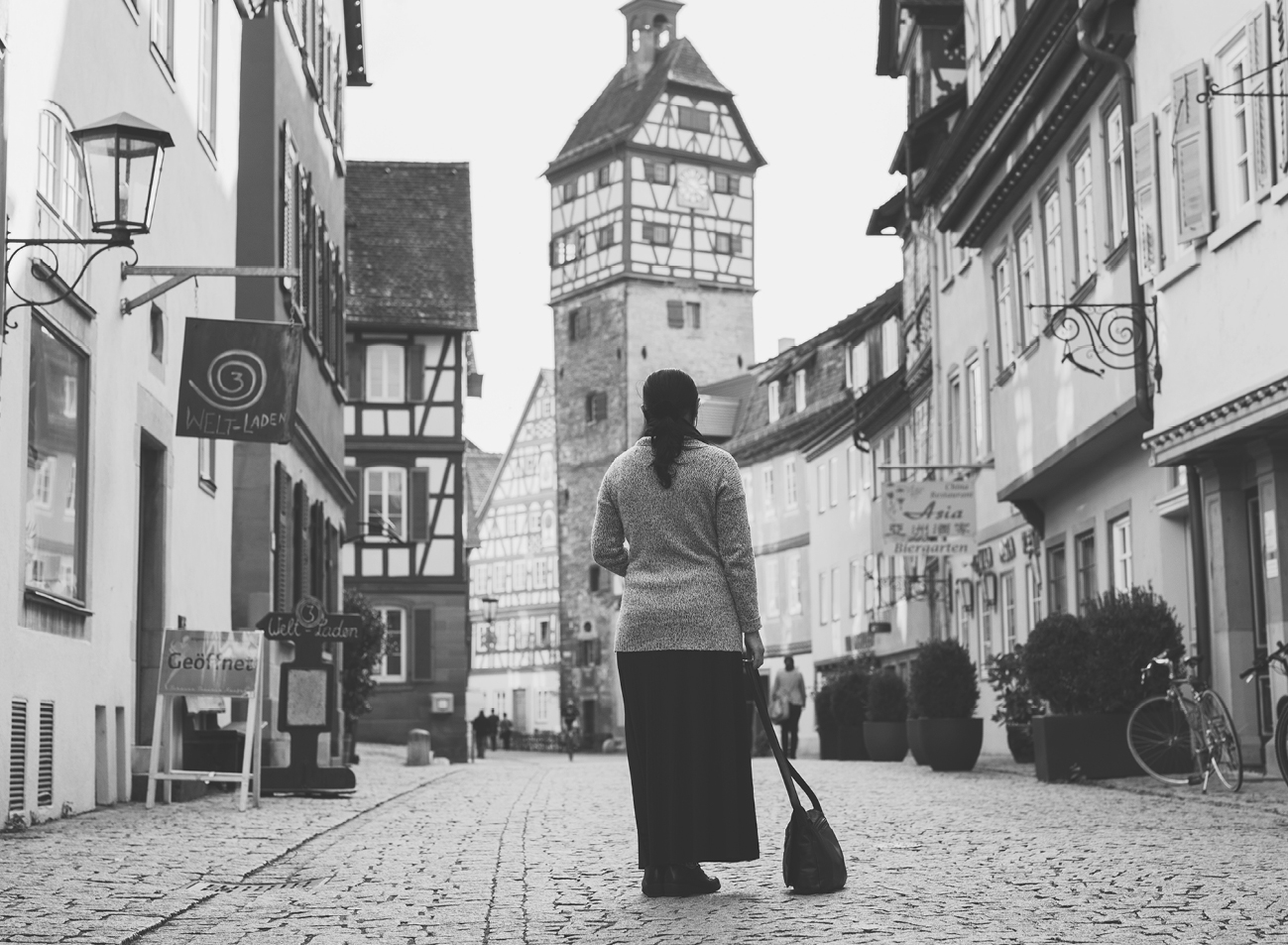
Turko in Schwabisch Hall (Georgios Makkas/Panos Pictures)
Turko was kept by the prison warder for two months until one of her uncles eventually paid $2500 to get her and her niece freed. On 25 May 2015, after more than nine months in captivity, she was taken to a refugee camp in northern Iraq.
On her hand was a small tattoo which she told me was the name of her brother. ‘I have no one else,’ she said. ‘My father died years ago and the last time I saw my mum was in the ISIS prison when we were first captured. From my whole family so many died.
‘That’s why when I heard about the air bridge to Germany, I applied to come with my sister-in-law and niece. What could we do in Iraq anymore, we who had been raped and dirtied?’
Germany had long had a sizeable Yazidi community and the idea of giving women like Turko shelter surfaced in September 2014 when local Yazidi leaders approached Winfried Krestchmann, premier of the southern state of Baden Württemburg. ‘Please do something!’ they begged as they showed him pictures of mass killings of their people in Sinjar, including beheadings and crucifixions, and told him of girls kept as sex slaves.
Krestchmann was a committed Christian and member of the Green Party and he was horrified. He spoke to Dr Michael Blume, an academic who was responsible for religious minorities for the state and married to a Turkish Muslim. They found that under German law it was possible for a province to intervene in a humanitarian crisis overseas, though it had never been done before.
That October the state government organised a refugee summit to bring together members of political parties, church leaders and mayors. All agreed they should help and arrange an air bridge from Iraq to bring out 1100 women and children who they would give three-year visas. Ninety million euros were apportioned to what they called the Special Quota Project and Dr Blume was appointed to run it.
‘The federal government said we, the state, would have to do everything ourselves,’ he said. ‘We didn’t know how – we had no army, no boots on the ground.’
Blume contacted Professor Jan Kizilhan, a psychologist specialising in trauma whose own family were Yazidi Kurds, and, in February 2015, they and a doctor set off for Iraq.
By then many of the enslaved women had escaped or, like Turko, had had their freedom bought and were in camps in Kurdistan in northern Iraq. Around 1600 women were referred to the German doctors. Each underwent an hour-long psychological assessment, a medical examination and a discussion of how they might benefit from the programme.
The stories were beyond imagination for the three German men. ‘After listening you don’t sleep,’ said Dr Blume.
There was the mother who told him how she had been forced to convert and read the Koran but stumbled over a passage so they tortured and killed her baby in front of her. An eight-year-old girl who had been sold from one man to another and raped hundreds of times. Or the young woman with the deeply scarred face and neck because she was so desperate she had set fire to herself.
‘As a man I feel ashamed and so does my wife as she is a Muslim,’ he said. ‘And as a German I know that less than a century ago our own European civilisation did such terrible things and we don’t seem to learn.’
It was perhaps no coincidence that Germany had been the country to take in the Yazidi women just as its leader Angela Merkel had been the one to say ‘wir schaffen das’ – ‘we can do this’ – as she opened the borders to one million refugees as the rest of Europe was closing theirs.
‘The hardest thing was deciding who to take and who not to take,’ Dr Blume said. ‘How do you decide between a woman who has lost two children and another who only lost one but it was killed in front of her?’
The first priority was emergencies. ‘Some were suicidal,’ he said, ‘or would have died because they were sick – gynaecological damage or terrible burns from self-immolation.’
For those remaining there were three key criteria – whether they had suffered traumatising violence; if they were without family support (if their husbands were alive they tended not to take them); and whether taking them to Germany would help them.
‘It was awful not to take all,’ said Dr Blume. ‘But every life is worth the effort.’
In March 2015 the first women were flown from Erbil to Stuttgart. Over the next year Blume made twelve trips to Iraq and brought over 500 women and 600 children. Of these around 1000 had been taken to Baden Württenburg, 60 to Lower Saxony and 32 in Schleswig Holstein.
It was an astonishing gesture by a single province. However, more than 5000 women were thought to have been enslaved, so Blume estimated that they had given refuge to only a third of those in need. ‘In the end around 2000 were referred and in the meantime the numbers grew because more girls managed to flee or bought their way out. So we believe there are still more than 2000 women needing help in camps in Iraq.’
Among the children rescued were young boys who had been beaten and forced to be child soldiers. These were all under thirteen as those fourteen or over were killed. ‘They were killed if they had hair on their ankles,’ said Blume.
As a father of two boys and a girl, he found the children’s stories particularly distressing. ‘Once I entered my office in Iraq and a thirteen-year-old Yazidi girl was standing there with her back to me and looked exactly like my daughter,’ he said. ‘She looked so similar, hair, everything … It made me realise it could have been ours. These children are like our children.’


